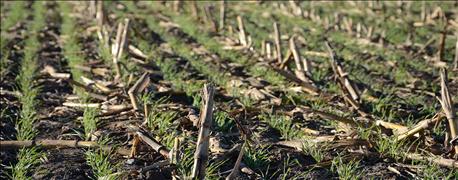August 31, 2016


The greatest near-term potential for reducing GHG emissions through agriculture comes from the planting of cover crops.
Agriculture can play a significant role in helping to reduce greenhouse gas (GHG) emissions according to a recent scientific report. As part of Monsanto Company’s commitment to make its own operations carbon neutral by 2021, the company commissioned third-party expert ICF International to examine the potential for reducing GHG emissions through agriculture in the United States. The resulting report, “Charting a Path to Carbon Neutral Agriculture: Mitigation Potential for Crop Based Strategies,” shows that widespread adoption of recommended practices could potentially result in more than 100 million metric tons of carbon dioxide-equivalent emissions reductions in the United States alone. That’s equal to the carbon absorption potential of more than 2.5 billion tree seedlings grown for 10 years.
Related: EPA report shows evidence of climate change
“This report shows promising results and helps confirm the significant impact farmers can make when they adopt and maintain the practices noted in the report,” said Michael Lohuis, Ph.D., Lead Scientist for Environmental Strategy for Agriculture, Monsanto. “The carbon-smart practices mentioned, coupled with innovations like biotechnology and advanced breeding, are vital tools that can help farmers adapt to and mitigate climate change. At Monsanto, we are committed to encouraging the use of innovative farming techniques and carbon smart practices that will help reduce emissions.”
Monsanto’s carbon neutral commitment included the sharing of data and modeling results with the broader agriculture community in hopes of encouraging the adoption of best practices and reinforcing the role carbon neutral cropping systems can play in reducing GHG emissions.
The report focused on near-term strategies, including:
-Cover crops. The report found that the greatest near-term potential for reducing GHG emissions through agriculture comes from the planting of cover crops. Cover crops, which are currently grown on only about 3%-5% of U.S. crop acreage, can prevent soil erosion and help to absorb and keep carbon stored in the soil.
-Conservation tillage. The second largest potential comes from reducing or eliminating soil tillage, which enables farmers to save money and resources while limiting the amount of carbon released from the soil into the atmosphere. This practice also helps preserve soil structure and soil organisms, which improves soil health.
-Precision nutrient management. Precision agriculture and nitrification inhibitors can be effective in reducing GHG emissions. Precision agriculture helps determine the appropriate amount of fertilizer and pesticide to use on the field, and where they need to be applied. By using GPS guidance and variable rate technology when applying the inputs, farmers optimize nutrient and fuel use while improving profitability. By adding inhibitors, farmers utilize fertilizer more efficiently, reducing emissions and achieving the same yield.
Long-term strategies also can help reduce carbon emissions, but will require more research and time to scale-up. These strategies include:
-Ethanol production from corn stover. Corn stover represents a sizeable renewable source of biomass to augment ethanol production. This material could help reduce emissions from fossil fuels while sustainably managing excess crop residues in the field.
-Utilize crop material left in the field after harvest. There also is a possibility that available excess corn stover could be burned alongside coal in coal-fired power plants, which would reduce the amount of fossil fuel used through the use of this renewable source of energy. Available corn stover also could be processed into plant-based charcoal (biochar) that could be incorporated into the soil to increase soil health and store carbon in the soil not in the atmosphere.
“Agriculture has the potential to play a critical role in addressing climate change,” said Debbie Reed, executive director with the Coalition for Agricultural Greenhouse Gases. “This report adds another critical set of data points to help quantify and demonstrate how the agriculture community can take actionable steps, both in the near-term and long-term that will have a substantial and positive impact on our planet.”
Source: Monsanto
You May Also Like




